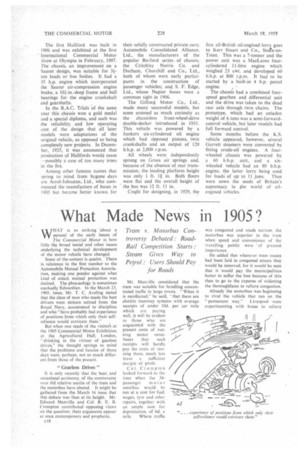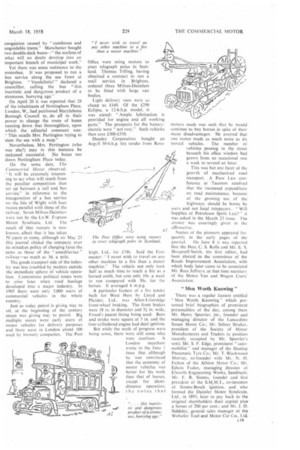What Made News in 1905?
Page 150

Page 151

If you've noticed an error in this article please click here to report it so we can fix it.
Tram v. Motorbus Controversy Debated.' RoadRail Competition Starts : Steam Gives Way to Peirol : Users Should Pay for Roads
11 THAT is so striking 'about a
perusal of the early issues of
The Commercial Motor is how little the broad social and other issues imderlving the technical development of the motor vehicle have changed.
Some of the content is quaint. There is reference in the first number to the Automobile Mutual Protection Association, making one ponder against what kind of attack mutual protection was desired. The phraseology is sometimes markedly Edwardian. in the March 23, 1905. issue, Mr. T. C. Aveling stated that the class of men who made the best drivers were stokers retired from the Royal Navy, accustomed to discipline and who "have probably had experience of positions from which only their selfreliance would extricate them."
But when one reads of the visitors at the 1905 Commercial Motor Exhibition at the Agricultural Hall, London, drinking in the virtues of gearless drives," the thought springs to mind that the problems and fancies of those days were, perhaps, not so much different from those of the ptesent.
"Gearless Drives"
It is only recently that the heat, and occasional acrimony, of the controversy over tU relative merits of the tram and the motorbus have abated. It might be gathered from the March 16 issue that this debate was then at its height. Mr. Edward Manville and Col. R. E. B. Crompton contributed opposing views on the question; their arguments appear at once contemporary and prophetic.
r.18 buses that such receipts will hardly pay the costs of running these, much less leave a sufficient margin of peoilt.
Col. Crompton looked forward to the time when the 34passenger motor omnibus would he run at a cost for fuel, wages, tyre and other repairs, together with an ample sum for depreciation, of 6d. a
mile. Where traffic
was congested and roads narrow, the motorbus was superior to the tram when speed and convenience or the travelling public were of greatest importance.
lie added that wherever tram routes had been laid in congested streets they would be removed, for it would be seen that it would pay the municipalities better to suffer the loss because of this than to go to the expense of widening the thoroughfares to relieve congestion.
Already the motorbus was beginning to rival the vehicle that ran on the "permanent way." Liverpool were experimenting with buses to relieve congestion caused by "cumbrous and unguidable trams." Manchester bought two double-deck buses—" the nucleus of what will no doubt develop into an important branch of municipal work." Yet there was some resistance to the motorbus. if was proposed to run a bus service along the sea front at Brighton. " Vandalistic! " declared a councillor, calling the bus "this inartistic and dangerous product of a strenuous, hurrying age."
On April 20 it was reported that 28 of the inhabitants of Nottingham Place, London, W., had petitioned Marylebone Borough Council to do all in their power to change the route of buses running down that thoroughfare, upon which the editorial comment was: "This recalls Mrs'. Partington trying to stem the sea with a mop."
Nevertheless, Mrs. Partington (who was she?) may in this instance be reckoned successful. No buses run
down Nottingham Place today. On the same date, The Commercial Motor observed: It will be extremely interesting to sec what will result from
the peculiar competition thus set up between a rail and bus service," in reference to the inauguration of a bus service on the Isle of Wight with four routes parallel with those of the railway. Seven ivlilnes-Daimlers were run by the I.o.W. Express Motor Syndicate. Ltd. The result of that venture is now known, albeit that it has taken 50 years to come, although on May 25 this journal Aided the company over its mistaken policy of charging fares the same as those of the "antediluvian " railway—as 'much as 3d. a mile.
The goods transport side of the industry was less troubled by matters outside the immediate sphere of vehicle operation. Contentious political issues were to arise later when road haulage developed into a major industry. In 1905 there were only 3,000 users of commercial vehicles in the whole country.
Just as today petrol is giving way to oil, at the beginning of the century steam was giving way to petrol. Big multiple stores were early users of motor vehicles for delivery purposes and there were in London about 100 used by brewery companies. The Post Office were using motors to erect telegraph poles in Scotland. Thomas Tilling, having obtained a contract to run a mail service in Brighton, ordered three Milnes-Daimlers to be fitted with large van bodies.
Light delivery vans were as cheap as £160. Of the £290 Eclipse, a 12-b.h.p. model, it was stated: " Ample lubrication is provided for engine and all working parts.The prospects for the batteryelectric were "not rosy." Such vehicles then cost £300-1350.
Dundee Corporation bought an Argyll 50-b.h.p. fire tender from Ross
leigh, Ltd., for £746. Said the Firemaster: " I never wish to travel on any other machine to a fire than a motor machine." The vehicle not only took half as much time to reach a fire as a horsed outfit, but cost only 10s. a week to run .compared with 30s. for the horses. It averaged 6 m.p.g.
A particular feature of a fire tender built for West Ham by Lloyd and Plaister. Ltd.. was Allen-Liversidge front-wheel braking. The front brakes were 18 in. in diameter and 3-1 in. wide. Frood's patent lining being used. Bore and stroke were square at 5 in. and the four-cylinderecl engine had dual ignition.
But while the seeds of progress were being sown, there were still some who were cautious. A London merchant wrote in the June 1 issue that although he was convinced that the economy of motor vehicles was better for his work than that of horses, except for shortdistance operation, the noise that motors made was such that he would continue to buy horses in spite of their many disadvantages. He averred that one motor made as much noise as six horsed vehicles. The number of vehicles passing in the street beneath his office window had grown from an occasional one a week to several an hour.
This was but one facet of the growth of mechanized road transport. A Poor Law conference at Taunton reSolved that the increased expenditure on road maintenance, because of the growing use of the highways, should be borne by users and not local ratepayers. "Will Supplies of Petroleum Spirit Last? " it was asked in the March 23 issue. The answer was assuringly given in the affirma live.
Names of the pioneers appeared frequently in the early pages of the journal. On June 8 it was reported that the Hon. C. S. Rolls and Mr. E. S. Shrapnell-Smith, the first editor, had been elected to the committee of the Roads Improvement Association, with which body later came to be associated Mr. Rees Jeffreys, at that time secretary of the Motor Van and Wagon Users' Association.
"Men Worth Knowing"
There was a regular feature entitled "Men Worth Knowing" which presented brief biographies of prominent personalities of the day, among them Mr. Henry Spurrier, Or., founder and -managing director of the Lancashire Steam Motor Co.; Mr. Sidney Straker, president of the Society of Motor Manufacturers and Traders (a position recently occupied by Mr. Spurrier's son); Mr. S. F. Edge, prominent " automobilist " and manager of the Dunlop Pneumatic Tyre Co.; Mr. T. Blackwood Murray, co-founder with Mr. N. 0. Fulton of the Albion Motor Co.; Mr. Edwin Foden, managing director of Elworth Engineering Works, Sandhach; Mr. F. R. Simms, founder and first president of the S.M.M.T., co-inventor of Simms-Bosch ignition, and who formed the Daimler Motor Syndicate, Ltd.. in 1893, later to pay back to the original shareholders their capital plus a bonus of 200 per cent.; and Mr. J. D. Siddeley, general sales manager of the Wolseley Tool and Motor Car Co.. Ltd.








































































































































































































































































